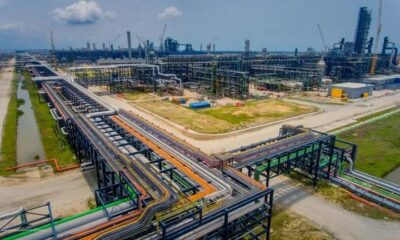
ROCKDALE, Texas – Chad Harris, the CEO of Whinstone Inc., the operator of the largest crypto “mine” in North America, remembers one of the last times Texas’s electric power problem became his electric power problem.
It was a Wednesday in June, and evening temperatures were hovering around 94 degrees – far higher than the state usually suffers at that time of year. Texans were churning up their air conditioning, and the state’s grid, which infamously failed for days during a cold snap in February, was straining.
“We just got a text saying, ‘The power grid needs support. Please curtail now,’ ” Harris said, while standing outside the company’s mining center at an old Alcoa aluminum facility about six miles outside this Central Texas town. Instantly, Whinstone’s system went offline. The tens of thousands of computer servers that spin away generating bitcoin inside three long buildings simply stopped. “With the flip of a switch, we turned this off,” Harris said.
In the world of crypto mining, having all your computers shut down at once, and stay down for hours, as they did in June, sounds like a disaster. Crypto miners compete with one another the world over to generate the computer code that results in the production of a single bitcoin, and the algorithm that governs bitcoin’s production allows only 6.25 bitcoin to be produced every 10 minutes, among the perhaps 70,000 crypto mines that operate around the world. If you’re not able to generate the code, but your rivals can, you are out of luck.
But thanks to the way Texas power companies deal with large electricity customers like Whinstone, Harris’s bitcoin mine, one of the few owned by a publicly traded company, didn’t suffer. Instead, the state’s electricity operator, the Electric Reliability Council of Texas (ERCOT), began to pay Whinstone – for having agreed to quit buying power amid heightened demand.
That sort of arrangement has helped make the state one of the go-to locations for expanding crypto entrepreneurs the world over, despite its continued agonizing over power shortages. Indeed, Whinstone’s new owners are undertaking a major expansion of its facility outside Rockdale, with the intention of doubling its capacity. When fully developed, the crypto mine here is expected to require 750 megawatts of power – enough to power more than 150,000 Texas homes during peak demand.
And it’s not just Whinstone. More crypto farms want to move into the area as China, believed to be the nation with the most crypto miners, moves to restrict local bitcoin mining and trading by, among other limitations, ordering power companies not to sell them power. Shenzhen-based BIT Mining said in May that it plans to invest more than $25 million in a Texas data center, while Beijing-based server firm Bitmain is already modernizing the old aluminum plant across the street from Whinstone’s Rockdale-area facility.
Rockdale’s mayor, a bitcoin miner himself with a rack of computers in his home, says he’s met with at least one other firm interested in locating here. Whinstone, which leases shelving on its campus to other crypto miners’ servers, has been contacted by “several,” the company’s CEO said.
It’s not just happening near Rockdale. Peter Thiel-backed crypto mining firm Layer1 Technologies last year opened a plant near Pyote in West Texas (population 138 in the 2020 census). In February, Canada’s Argo Blockchain announced plans to buy 320 acres of land in the same West Texas area within a year.
Events in China might make mining even more profitable for farms in Texas. Over the July Fourth weekend, as bitcoin’s code self-adjusted to accommodate a sudden drop in global bitcoin miners tied to the crackdown in China, it became 28% less difficult to produce new bitcoin, according to the bitcoin data service BTC.com.

The boom is both a worry and an opportunity, depending on whose perspective you choose to adopt.
“One good thing about crypto mining is it’s adding flexibility to the system,” said Peter Cramton, a former board member of ERCOT, the nonprofit that’s charged with managing the state’s wholesale energy market. “But the problem is it’s consuming real resources, doing a function that has no value.”
In mid-June, the state asked Texans to cut back on power by setting their thermostats to 78 degrees or higher as statewide electricity demand crept toward 70 gigawatts, nearly all that companies could generate at the time.
How much the crypto explosion has helped Rockdale’s economy is open to debate. For 50 years, Rockdale, with a population of about 5,600, was a company town, with hundreds of jobs at Alcoa’s nearby coal mine and aluminum smelter. Its economic success even earned it the nickname “The Town Where It Rains Money” in a 1952 article by the Saturday Evening Post. But in 2008, Alcoa closed the mine and smelter, eliminating 1,200 jobs, and in 2018 the firm’s power plant was shut down, adding to those job losses.
But the electrical lines supporting those operations remain, making it an attractive site for bitcoin investment. Whinstone hired roughly 100 workers when it moved into town. But so far, the investment hasn’t spurred meaningful growth.
“What’s 100 [newly hired] employees when you lost maybe 2,000 employees? It’s not significant,” said John King, Rockdale’s mayor, who worked at the old Alcoa plant in the 1980s. His efforts to operate a crypto mine with a few servers in his home hasn’t really paid off either. “I’m not very successful at it, and I can’t afford to keep buying hard drives,” he said, a reference to the hotly competitive market where the winnings go to those with the most computing power.
And Whinstone has a lot. The company’s fenced-off crypto compound houses more than 100,000 computer servers, stacked 20 feet high lining some of the walls. When the expansion is completed by the end of 2022, that number will have more than doubled, according to the company’s CEO.
On the outside, machines can be heard buzzing as workers in hard hats prep the 100-acre lot in near 100-degree temperatures for mining expansion. It’s even louder and hotter on the inside, where fans on mining servers expel heat into a central “hot aisle.” When the power is on, the chamber can hit 150 degrees as scorching air is shot out the ceiling. When the system powers down, the chamber’s temperature falls soon after.
Bitcoin mines of Whinstone’s size may be capable of creating roughly 500 bitcoin per month, the company says. At today’s bitcoin value of approximately $34,000, that’s $17 million, helping to explain why Riot Blockchain, a publicly traded company, paid $80 million in May to acquire Whinstone.
Expansion is an expensive undertaking, too. Each of Whinstone’s buildings costs about $40 million to build. Still, Whinstone feels bullish on its future in Texas. The state provides myriad prime conditions for mining.
For one, it has a deregulated electricity landscape that allows energy customers to choose their provider. The state often offers some of the cheapest energy prices in the country. And the arid locale known for its oil and gas business is the nation’s leading energy producer. As such, crypto data centers requiring a seemingly endless amount of power know where to get it.
When power prices start to rise because of increasing demand, software from start-ups like Texas-based Lancium give mines the flexibility to adjust their power consumption accordingly. The code is interfaced with online notices from ERCOT, triggering servers to power down during times of extreme energy shortages.
During the days-long blackout that crippled Texas in February, bitcoin mines completely went offline. ERCOT paid the companies for doing so.
“There’s a lot of opportunities here compared to other states,” said Katie Coleman, an Austin-based energy attorney. “Cryptocurrency miners can avoid high energy periods, get paid for doing that, and therefore get power for next to nothing here.”
Why Rockdale? Whinstone moved to the town’s perimeter from Louisiana in 2019 to take advantage of relaxed regulations and Alcoa’s shuttered facilities. The company signed a long-term lease with Alcoa, flattened trees on the unkempt land and completed three buildings in 18 months.
Wanting to be well-liked among locals, Whinstone donated “a significant amount of money” to the Rockdale Police Department. “Then they probably spent $5,000 on fireworks for our graduating senior class,” King, the mayor, said.
The showering display was a notable investment, he added, in a four-square-mile town that hosts a Walmart, one other grocery store, a handful of Mexican restaurants and a couple of pizza places. It’s also home to one of the oldest motels in Texas, Rainbow Courts, which is somewhat of a tourist destination built over a century ago.
The move to the community’s perimeter came as the start-up was running low on capital. The firm says it needed the recent Riot Blockchain buyout to expand. Riot needed Whinstone’s infrastructure to run its mining hardware.
“Our issue here was getting enough capital to build faster,” said David Schatz, vice president of operations at Whinstone. “We virtually had an endless supply of power, whereas other companies, our competition – their issue is scaling up their power.”


 NEWS5 months ago
NEWS5 months ago
 NEWS5 months ago
NEWS5 months ago
 NEWS5 months ago
NEWS5 months ago
 WAR5 months ago
WAR5 months ago
 FINANCE5 months ago
FINANCE5 months ago
 INVESTMENTS5 months ago
INVESTMENTS5 months ago
 FINANCE5 months ago
FINANCE5 months ago
































